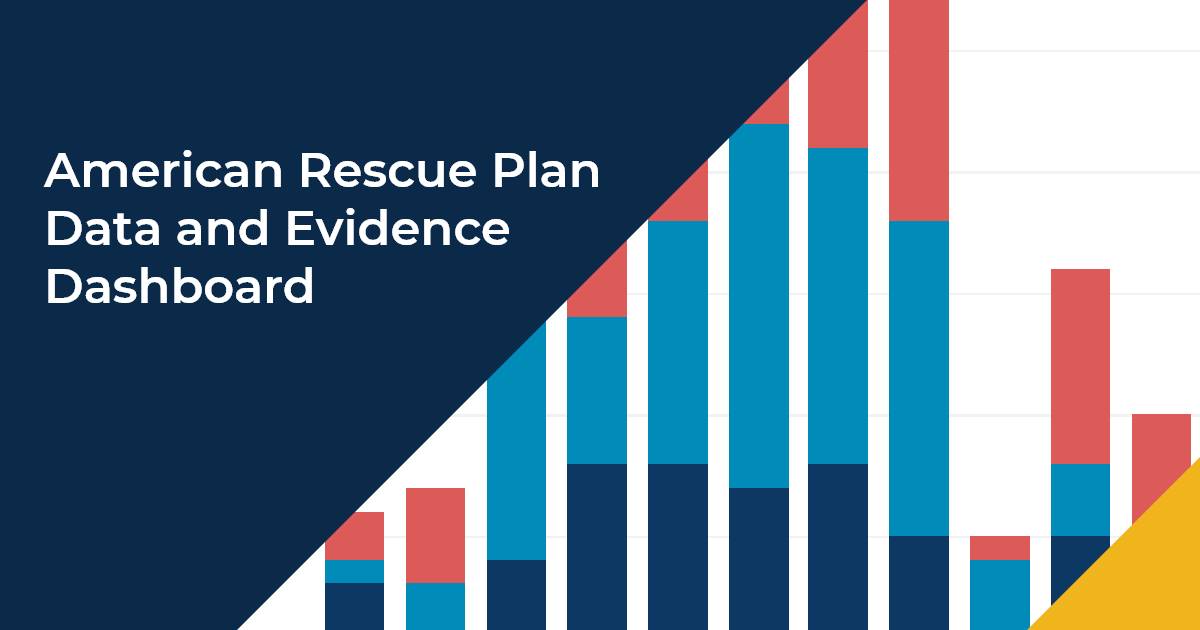Results for America and Mathematica released an updated tool—the American Rescue Plan (ARP) Data and Evidence Dashboard—that highlights how state and local government leaders are investing one-time federal pandemic relief and economic recovery funds and using data and evidence to get better results.
The dashboard, which is based on an analysis of 200 publicly available Recovery Plan Performance Reports submitted to the U.S. Department of Treasury by 50 states, 87 counties, and 67 cities across the country, provides a snapshot of these jurisdictions’ funding priorities. It also shows how state and local policymakers are implementing five key data and evidence practices that serve as criteria for how governments should invest ARP dollars to advance economic mobility and racial equity.
“The federal government provided state and local government leaders with the guidance and incentive to use ARP dollars to build data and evidence capacity and invest in evidence-based solutions—and we are thrilled to see policymakers acting on that,” said Michele Jolin, CEO and co-founder of Results for America. “Given the amount of federal relief funding still to be allocated, the examples in this dashboard can be used as a road map for other state and local governments to get better results.”
“The ARP was a historic investment in state and local public health and economic recovery programs,” said Paul Decker, president and CEO of Mathematica. “With this dashboard, we’re providing state and local lawmakers with real examples of successful evidence-driven projects that they can replicate across the country to improve public well-being. We’re also making it easier for people to see how their lawmakers are investing ARP funding in their communities. Mathematica is pleased to partner with Results for America on this important effort.”
The ARP provided $350 billion in Coronavirus State and Local Fiscal Recovery Funds to states, territories, cities, counties, and tribal governments to make critical investments in people and infrastructure. The dashboard includes an analysis of more than 8,300 projects from 200 reports submitted to the U.S. Treasury, including 110 notable projects that can serve as models for other government leaders. These include the following:
- 24 evidence-based solutions (totaling $302 million) that can serve as models for other government leaders
- 44 examples (totaling $338 million) of state and local governments building evaluations into their investments
- 44 examples (totaling $574 million) of state and local governments developing their in-house data and evidence capacity
Innovative Approaches from State and Local Governments
The information and notable examples cited in the dashboard can help policymakers better plan their next ARP investments by learning from innovative practices in communities across the country. Here are just a few:
- Using Evidence-Based Solutions in Minnesota: Minnesota is a national leader in identifying, using, and creating rigorous evidence of effectiveness for social programs. In 2015, Minnesota, having developed a definition of evidence-based practices, began to evaluate whether there was an evidence basis for select programs operated by the state. This approach was central to how Minnesota invested its Coronavirus State and Local Fiscal Recovery Funds. State agencies are encouraged to use the request for proposal process to promote the use of evidence-based interventions and conduct rigorous impact evaluations.
- Using Evidence-Based Solutions in Lee County, Florida: Lee County is investing in Big Brothers Big Sisters, a program that matches mentors with children for positive impact. Rigorous evaluations show improved academic achievement from this model, which addresses educational disparities by providing advocacy, guidance, support, and resources to overcome barriers and achieve success in education and in life overall.
- Using Evidence-Based Solutions in Dallas, Texas: Dallas invested ARP funds in Family Connects, an evidence-based home-visiting model available to all families with newborns residing in a defined service area. Families with newborns have the opportunity to participate in up to three home visits with a nurse to help with the transition, identify any additional needs, and connect with a range of community support and resources.
- Investing in Evaluation in Baltimore, Maryland: The Baltimore Mayor’s Office of Recovery Programs will partner with the University of Baltimore and Morgan State University to support program evaluation, research, and evidence-based decision making on programs and services created or expanded using ARP funds. The university partners will provide the Mayor’s Office of Recovery Programs with implementation advice and impact evaluation, best practices research, administrative data analysis, and performance management.
- Building Data and Evidence Capacity in Chicago, Illinois: The Chicago Department of Public Health is building internal data and evidence capacity by hiring staff to support enhanced data collection. This will enable deeper analysis, which will allow the department to understand the distribution of pollutants and relative vulnerability of different Chicago neighborhoods. Using these funds, the department will collaborate with the Mayor’s Office for Sustainability to conduct a cumulative impact assessment.
Contact
-
J.B. Wogan
jwogan@mathematica-mpr.com
202-250-3547


